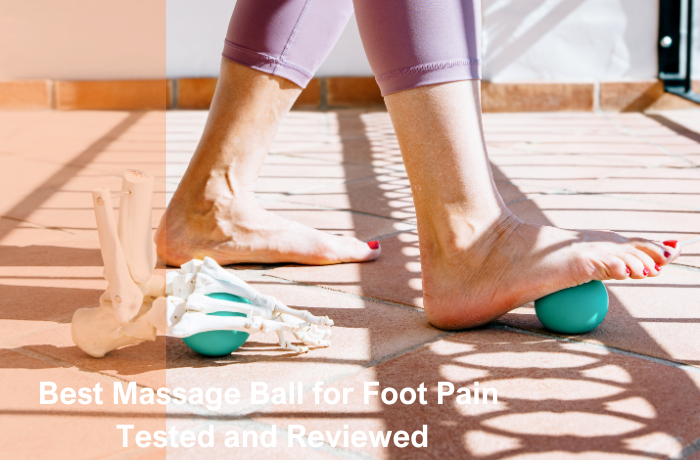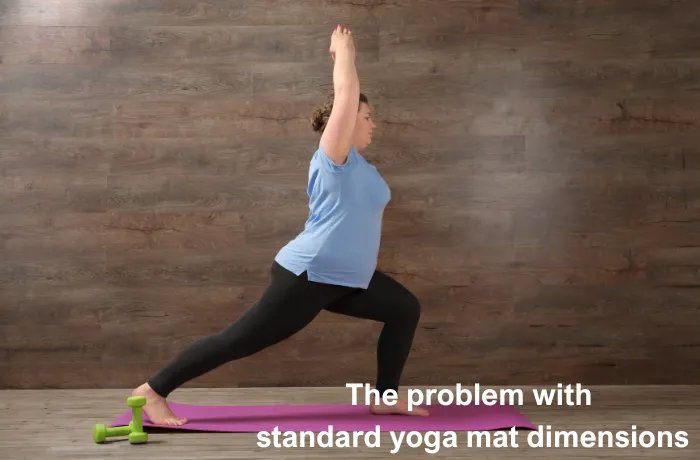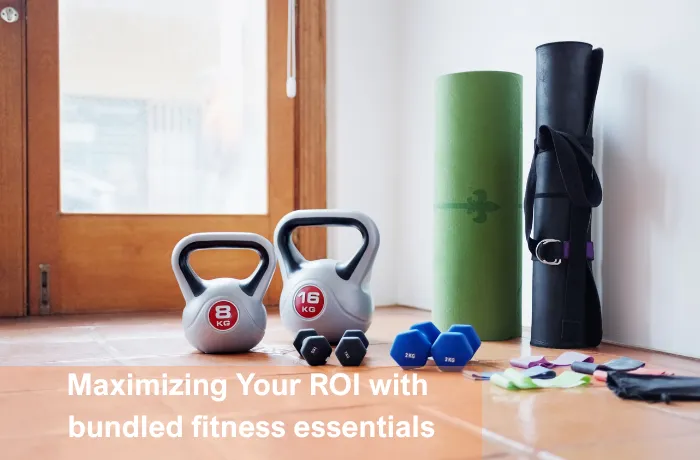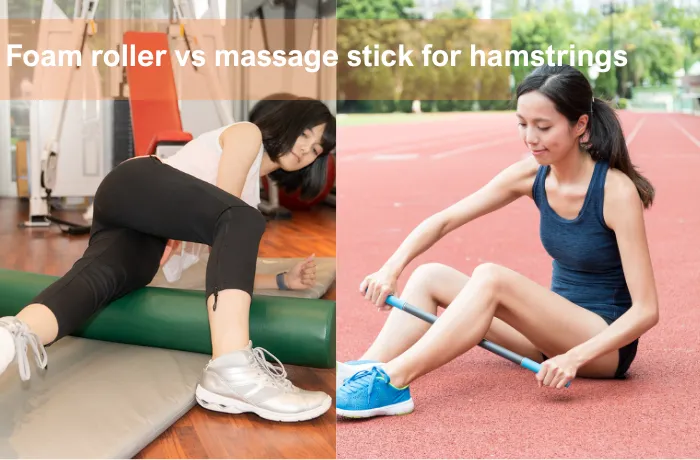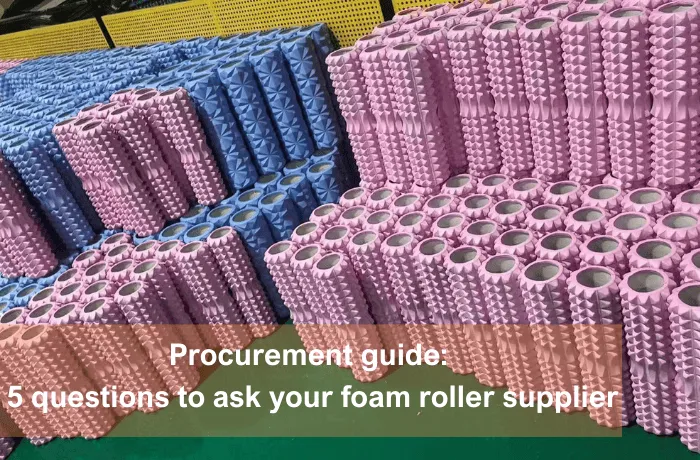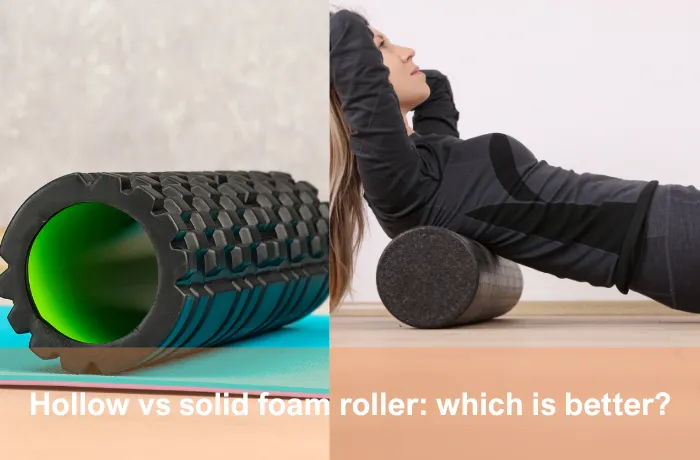If you want the best massage ball for foot pain, you need one that really helps you. The right massage ball can help a lot. It does not matter if you have plantar fasciitis, arch pain, or heel aches. Many people have foot pain. You might not know how common it is. Just look at these numbers:
| Statistic Description | Percentage / Number |
|---|---|
| Adults who will experience plantar fasciitis in lifetime | Approximately 10% |
| Americans treated annually for plantar fasciitis | About 2 million |
| Plantar fasciitis patients reporting pain under the heel | 55% |
| Plantar fasciitis patients reporting pain under the arch | 52% |
| Plantar fasciitis patients reporting pain at upper heel | 38% |
| Plantar fasciitis as cause of heel pain in middle-aged adults | Most common cause |
| Plantar fasciitis prevalence among runners | Up to 22% (in some studies) |
| Plantar fasciitis accounts for foot disorders | 15% |
| Plantar fasciitis patients as % of orthopaedic visits | About 1% |
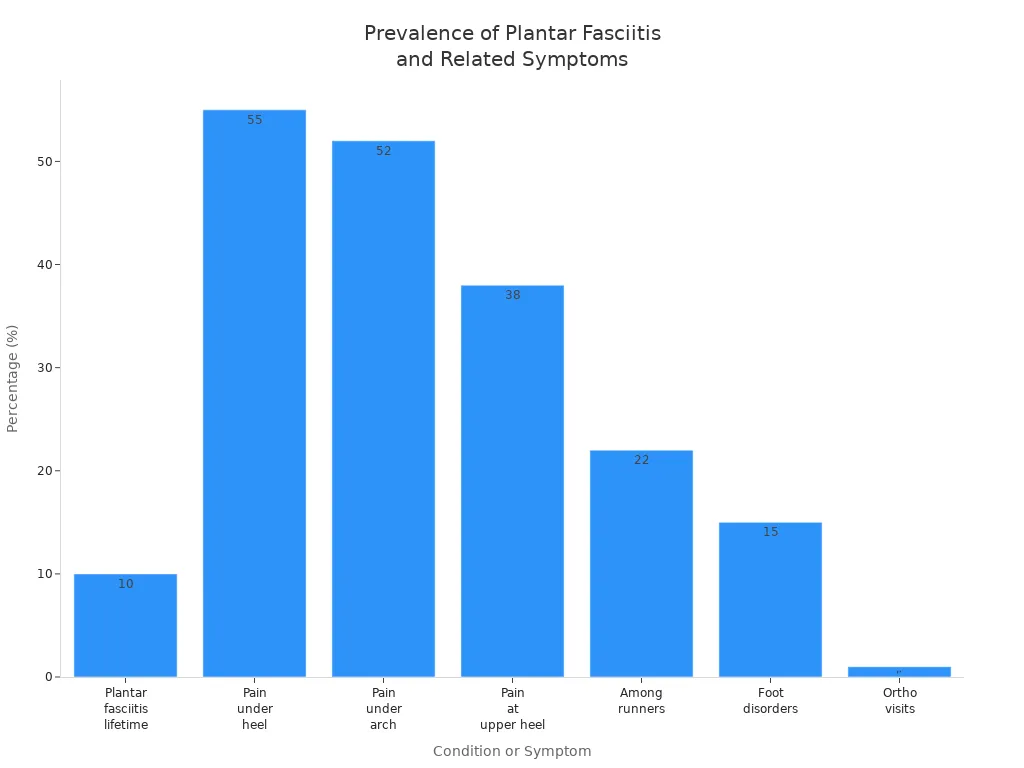
There are many massage balls to choose from. Some are spiky, some are foam, and some are rubber. But not all of them really help with foot pain. I have tried the most popular ones. Now you can choose the best massage ball for your feet. This will help you move without pain again.
Key Takeaways
- The Fitbeast massage ball is the top pick for foot pain. It gives strong but comfy pressure. Its size fits the foot very well.
- Pick a massage ball that matches what you need. Foam balls are good for feet that are sensitive. Spiky balls give strong pressure. Peanut-shaped balls work well for the arches.
- Use massage balls every day by rolling them under your foot. Move slowly and stop on sore spots. Change the pressure so it does not hurt.
- Clean your massage ball by wiping it after each use. Wash it with mild soap often to keep it clean and strong.
- If your foot pain stays or feels sharp, stop using the ball. Talk to a healthcare professional to get the right help.
Best Overall Massage Ball
Top Pick Summary
You want the best overall massage ball for foot pain. After testing many options, the Fitbeast massage ball stands out as the top choice. This ball gives you deep tissue relief, targets stubborn knots, and works well for both beginners and experienced users. The Fitbeast ball uses a smart ergonomic design that fits the natural shape of your foot. You can use it on your arches, heels, and even other muscle groups.
Here’s a quick look at why the Fitbeast massage ball is the best overall massage ball for most people:
- Made from high-quality, non-toxic, and eco-friendly materials
- Firm enough for deep pressure, but not too hard for sensitive feet
- Perfect size (about 2.5 inches in diameter) for targeting foot pain
- Superior grip, so it won’t slip during use
- Easy to clean and built to last
- Affordable and widely available
🏆 Tip: If you want a massage ball that works for both foot pain and other sore spots, the Fitbeast ball is a smart investment.
Why It’s the Best?
You might wonder what makes the Fitbeast the best overall massage ball. Let’s break it down. The material matters a lot. This ball uses premium rubber that feels firm but not harsh. It holds up well, even if you use it every day. The size is just right—about 2.5 inches—so you can reach the arch, heel, and ball of your foot with ease. Dr. Emily Johnson, a podiatrist, says this size gives you the best balance of pressure and control. You get relief where you need it most.
The texture also plays a big part. The Fitbeast has a smooth surface, which means you get even pressure without any sharp spikes. This makes it great for people with sensitive feet or those new to massage balls. If you want more intense stimulation, you can always try a spiky ball later.
You’ll notice the difference after just a few sessions. Many users say they feel quick pain relief, better flexibility, and even improved sleep. Over 90% of people on Reddit agree that this is the best massage ball for deep knots and stubborn tension. The ball’s grip keeps it steady, so you don’t have to chase it around the floor.
You can use the Fitbeast ball on other parts of your body too. It works well for calves, glutes, and shoulders. This versatility means you get more value for your money. The ball is also sweat-resistant and easy to clean, so you don’t have to worry about hygiene.
If you want a massage ball that ticks all the boxes—comfort, durability, effectiveness, and price—the Fitbeast is the best overall massage ball for foot pain. You can use it at home, at work, or even when you travel. It’s a simple tool, but it makes a big difference in your daily comfort.
Massage Balls Comparison
Quick Overview Table
There are many massage balls to pick from. It can feel confusing at first. This table shows some of the most popular choices for foot pain. You can see what makes each one special.
| Type | Material | Firmness | Best For | Size (approx.) | Key Feature |
|---|---|---|---|---|---|
| Spiky Massage Ball | Plastic/Rubber | Firm | Plantar fasciitis, knots | 2-3 inches | Deep tissue, trigger points |
| Foam Massage Ball | EVA Foam/Silicone | Soft | Sensitive feet, recovery | 2-4 inches | Gentle, comfortable |
| Rubber Massage Ball | Rubber | Medium-Firm | General pain, arch pain | 2-3 inches | Good grip, versatile |
| Peanut Massage Ball | Rubber/Foam | Medium | Curved areas, arches | 2.5-4 inches | Ergonomic, stable |
| Acupressure Ball | Plastic/Rubber | Firm | Pressure points, tension | 2-3 inches | Stimulates pressure points |
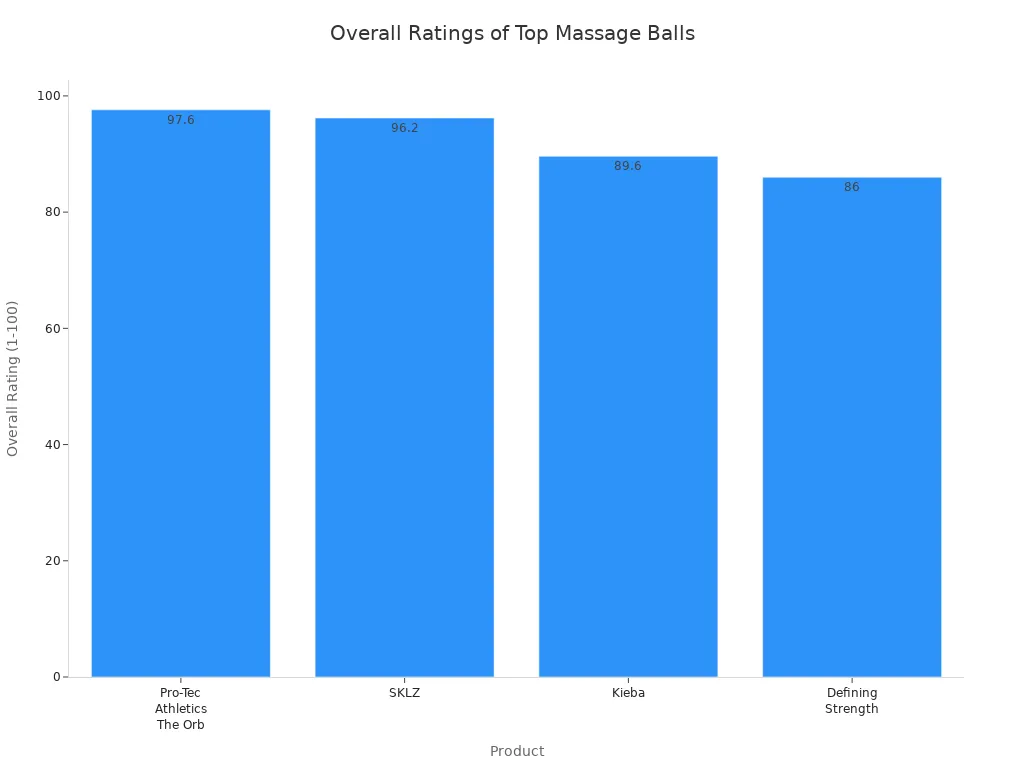
Key Features
You should know what to look for in a massage ball. Here are the main things to check before buying:
- Size: Small balls, about 2 inches, are best for feet. They help you reach sore spots easily.
- Material: Foam is soft and gentle. It is good if your feet hurt or are healing. Rubber is firmer and gives better grip. This helps if you want a stronger massage.
- Firmness: If you want a soft touch, pick a softer ball. If you have tough knots or plantar fasciitis, a firmer or spiky ball works better.
- Surface Texture: Spiky or bumpy balls press deeper and help loosen tight spots. Smooth balls give a gentle massage and help blood flow.
- Grip: You do not want the ball to slip away. Rubber or textured balls stay in place, even if your feet get sweaty.
Massage balls come in many shapes and sizes. Peanut-shaped balls fit the curves of your foot and do not roll away. Acupressure balls press on certain points for fast relief. Studies show using massage balls at home can help as much as a professional massage. You get to control the pressure and feel better at home.
Reviews
Spiky Massage Ball (Neuro Ball)
If you want a massage ball that wakes up your feet, the Neuro Ball stands out. You get three tools in one: a spiky outer shell for muscle release, a sensory stimulator for nerve activation, and a smaller inner ball for pinpoint relief. The spiky surface presses into your foot, which helps loosen tight muscles and wakes up tired nerves. Many people use it for arch pain and plantar fasciitis. You can roll it under your foot or press down for a deeper massage.
What makes the Neuro Ball special?
- Made from food-grade silicone, so it feels soft but stays strong.
- Odourless and waterproof, so you can clean it easily.
- The spikes give you a deep tissue massage, which helps with stubborn knots.
Pros:
- Durable and easy to clean.
- Activates nerves and muscles at the same time.
- Great for arch pain and plantar fasciitis.
Cons:
- Some people might find the spikes too intense at first.
- No major drawbacks reported for foot pain.
You will notice your feet feel more awake and less sore after a few sessions. If you want a tool that does more than just roll, the Neuro Ball gives you options.
Acupressure Massage Ball (Body Back Foot Star)
You might want something that targets pressure points and melts away pain. The Body Back Foot Star acupressure massage ball does just that. Experts often recommend these massage balls for foot pain because they are small, portable, and affordable. You can use them at home, at work, or even while travelling.
One user shared that rolling this ball under their foot every day helped with severe plantar fasciitis. After a few weeks, their pain improved, and after six weeks, it disappeared. They loved the firmness and the relief it brought. Another person said the spiky ball soothed their heel pain and made walking easier. Dr. Liza Egbogah, an osteopath, explains that the spikes work by moving the fascia and muscles, which boosts blood flow and eases pain.
Features:
- Firm, spiky surface for deep pressure.
- Small size fits under your arch and heel.
- Easy to carry anywhere.
Pros:
- Relieves pain fast.
- Stimulates blood flow and acupressure points.
- Good for plantar fasciitis and heel pain.
Cons:
- Can feel intense if you have very sensitive feet.
- Takes a few tries to get used to the pressure.
If you want a simple tool that packs a punch, the Body Back Foot Star could be your new best friend for foot pain.
Foam Massage Ball (TriggerPoint MB1)
The TriggerPoint MB1 foam massage ball feels soft but still gets deep into your muscles. You might like this one if you have sensitive feet or want a gentle start. The foam has a bit of give, so it does not hurt your skin or nerves. You can use it on your feet, but it also works well on other sore spots.
- The MB1 helps with muscle tightness and boosts your mobility.
- The foam texture feels comfortable, even if you use it every day.
- You can use it on the floor or against a wall, so it fits your routine.
Pros:
- Comfortable for sensitive feet.
- Easy to use and carry.
- Gives targeted relief for tight muscles.
Cons:
- Not as firm as rubber or spiky balls, so it may not reach deep knots.
- Needs regular use for best results.
A male athlete said he liked the foam because it felt better on bare skin than harder balls. If you want a massage ball that feels gentle but still works, the MB1 is a solid choice.
Rubber Massage Ball (Yoga Tune Up Therapy Ball)
You might want a massage ball that feels firm and grips well. The Yoga Tune Up Therapy Ball uses natural rubber, which gives you a steady grip and just the right amount of firmness. You can use it for your feet, calves, or even your back. The ball’s surface helps you control the pressure, so you can start gently and work up to a deeper massage.
A scientific study showed that using these therapy balls on your calf muscles before stretching doubled your flexibility gains. It also made your muscles stronger, which helps your feet feel better. Many users say these balls help them move better, recover faster, and feel less pain. You can roll them on the wall or floor, which makes them easy to use.
Pros:
- Releases muscle tension and improves mobility.
- Great for recovery after exercise.
- Lets you control the pressure for comfort.
Cons:
- Can feel uncomfortable at first, so start slow.
- Needs practice to get the technique right.
- Does not fix posture pain instantly, but helps over time.
If you want a massage ball that supports your foot health and helps with tight muscles, the Yoga Tune Up Therapy Ball is a smart pick. Its ergonomic design fits well in your hand and under your foot.
Peanut Massage Ball
The peanut massage ball looks different from the others. Its shape lets you target the arch of your foot without rolling away. You can place it under your foot and roll from your toes to your heel. This shape makes it easy to reach sore spots and gives you more control.
Physical therapists and athletes use peanut massage balls for pain relief and muscle recovery. You can use them at home for self-care or in a clinic for therapy. Many people notice better range of motion, less soreness, and less stiffness after using this ball. It also boosts blood flow and helps reduce swelling.
Advantages:
- Targets the arch and sole of your foot.
- Stays in place, so you do not have to chase it.
- Works for other areas like your neck and back.
Disadvantages:
- Might feel awkward for some people, depending on your foot shape.
- Not great for big muscles like your thighs.
- Larger size can make it harder to carry.
Peanut massage balls help with balance and stability, which is good if you want to improve your foot strength. You get a massage that feels steady and focused, perfect for tired or sore feet.
Foot Issues
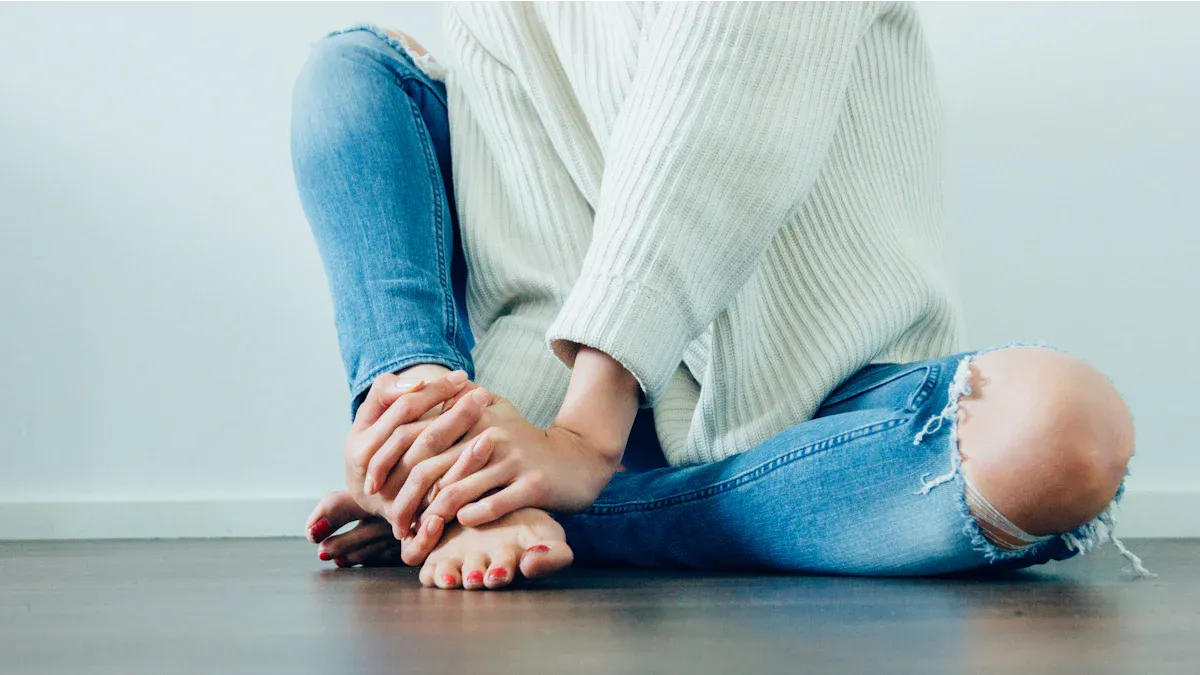
Plantar Fasciitis
You might hear about plantar fasciitis often if you have foot pain. This condition happens when the plantar fascia, a thick band of tissue under your foot, becomes irritated or stressed. You feel pain, especially in the morning or after sitting for a while. Many things can cause this problem:
- Limited ankle movement or a tight Achilles tendon
- High or low arches (pes cavus or pes planus)
- Carrying extra weight or standing for long hours
- Wearing high heels or unsupportive shoes
Plantar fasciitis is very common. It affects up to 10-15% of people, especially women aged 45-64 and those with a higher BMI. Runners and people who stand a lot at work also get it more often. The pain comes from overuse or strain on the plantar fascia. Doctors see more than a million cases each year. You can use a massage ball to help manage the pain. Studies show that both traditional and app-linked massage balls can improve symptoms, with no extra risk. Some people even find home massage with a ball practical and helpful.
Arch Pain
Arch pain can make every step feel tough. The plantar fascia supports your arch, so when it gets tight or inflamed, you feel pain there. Women, older adults, and people with a higher BMI get arch pain more often. Repetitive stress, like lots of walking or running, can also lead to problems. Sometimes, conditions like pes cavus, pes planus, or fat pad atrophy play a role. Metatarsalgia may also add to your foot discomfort.
| Leading Cause | Prevalence | Age Peak | Other Causes |
|---|---|---|---|
| Plantar fasciitis | ~10% lifetime | 40-60 yrs | Fat pad atrophy, foot deformities |
You can use a massage ball to roll under your arch. This helps loosen tight tissue and improve blood flow. Research shows that massage, especially with a ball, can reduce pain and boost mobility. Try rolling the ball under your arch for a few minutes each day.
Heel Pain
Heel pain often starts with the plantar fascia. About 12.5% of adults report pain in the back of the heel. One in three people over 65 will feel this at some point. Plantar fasciitis is the main cause, but Achilles tendonitis, bursitis, and nerve pain can also play a part. Age, weight, and even mood can affect your risk.
You can use a massage ball to target the heel area. Experts say this helps relax muscles, improve blood flow, and reduce inflammation. Clinical trials show that myofascial release with a massage ball can ease heel pain and make your foot more flexible. Start gently and avoid pressing too hard on sore spots.
Sore Feet
Sore feet can come from many causes. Osteoarthritis, fat pad atrophy, plantar fasciitis, and poor blood flow all play a part. Up to 80% of adults will have sore feet at some point. Risk factors include age, weight, and shoe choices.
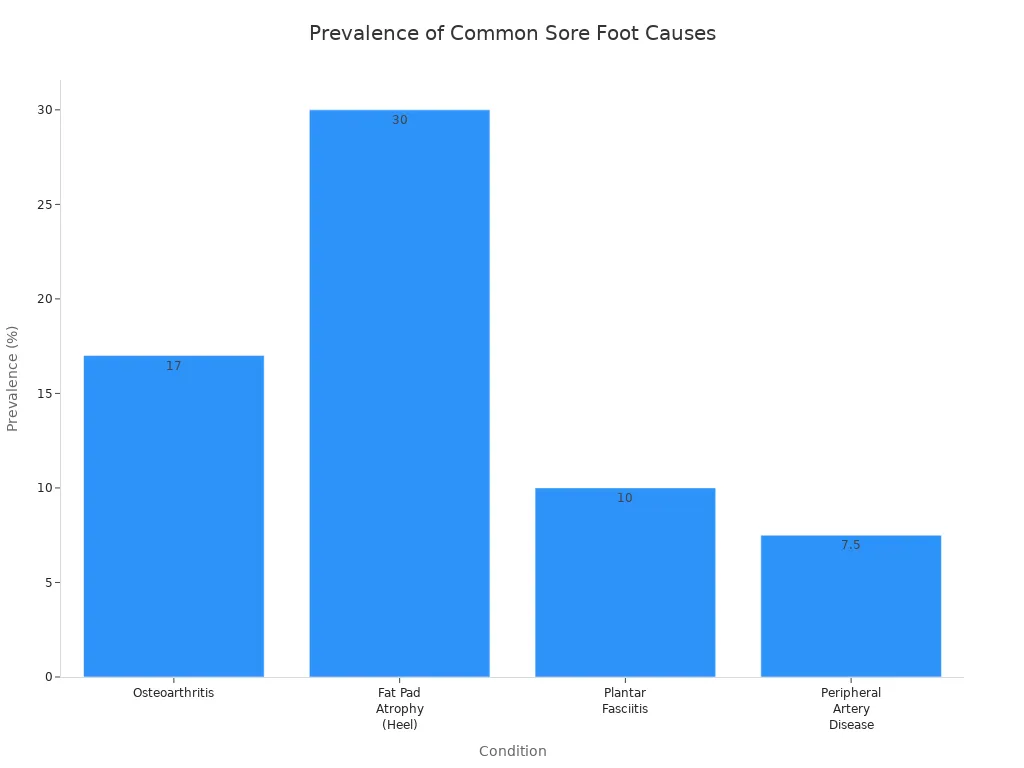
Massage balls can help. Studies show that using a massage ball reduces pain and fatigue, even for people with medical conditions. Massage therapy, including self-massage with a ball, improves mobility and helps you feel better after just a few weeks.
How to Use Massage Balls?
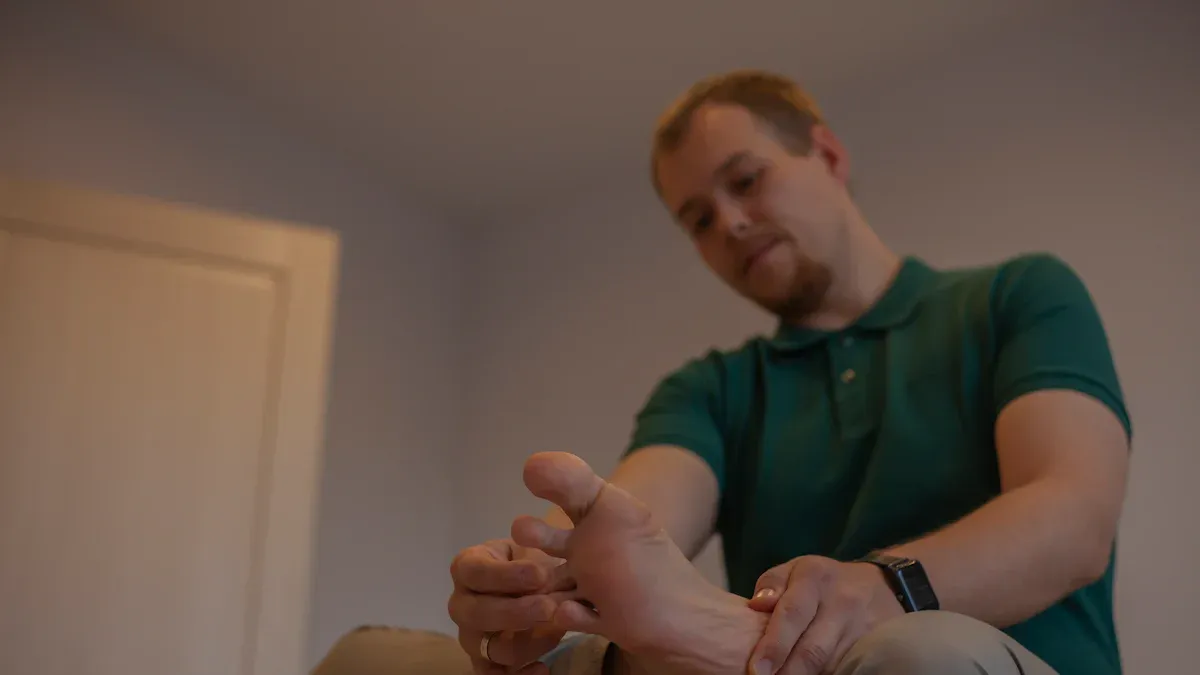
Step-by-Step Guide
You can get great results from self-massage with massage balls if you follow a simple routine. Here’s how you can start:
- Sit in a chair and place your foot on the massage ball.
- Roll the ball slowly from your heel to your toes. Use gentle pressure at first.
- If you find a sore spot, pause and let the ball rest there for about 10–20 seconds. This helps release tension.
- Keep rolling for about 60 seconds, then switch to the other foot.
- Take a short break before repeating. You can do this two or three times on each foot.
- Try different directions—side to side or in circles—to reach all areas of your foot.
- Use self-massage tools like a spiky or foam ball for different sensations. Start with a softer ball if your feet are sensitive.
💡 Tip: You can use these steps with other at-home massage tools too. Listen to your body and adjust the pressure as needed.
Safety Tips
You want your self-massage to feel good and help your feet, not hurt them. Keep these safety tips in mind:
- Never use so much pressure that it causes pain. The goal is relief, not discomfort.
- If you hit a painful spot, stop rolling and just rest the ball there with gentle pressure.
- Limit each massage to about a minute before taking a break.
- Use self-massage tools as a way to manage pain, but remember they offer temporary relief.
- If your feet are very sensitive, start with a tennis ball before moving to firmer massage balls.
- Always check with your doctor if you have ongoing, sharp, or burning pain.
- Avoid using massage balls on inflamed or injured feet.
- Begin with gentle pressure and increase slowly.
- Focus on soft tissue, not bony areas.
- Stop if you feel pain or discomfort.
- If you have health conditions like diabetes, arthritis, or blood clots, talk to a healthcare provider before starting self-massage.
🛑 Note: Clean your massage ball after each use to keep things hygienic.
Quality and Care
Material and Durability
When you pick a massage ball, you want one that lasts. The material makes a big difference. Most massage balls use rubber, silicone, foam, or plastic. Each type has its own feel and strength.
| Material | Feel | Durability | Best For |
|---|---|---|---|
| Rubber | Firm, grippy | High | Deep tissue, daily use |
| Silicone | Soft, flexible | High | Sensitive feet, hygiene |
| Foam | Soft, light | Medium | Beginners, gentle use |
| Plastic | Hard, smooth | High | Trigger points, acupressure |
Rubber and silicone balls last the longest. They do not crack or lose shape easily. Foam balls feel soft, but they can flatten over time if you use them a lot. Plastic balls stay hard, but sometimes they feel too intense for sore feet.
Tip: If you want a ball for daily use, choose rubber or silicone. These materials handle pressure and keep their shape.
You should also check the seams and surface. A good massage ball has no sharp edges. The surface should feel smooth or have even spikes. This helps you avoid skin irritation.
Cleaning
Keeping your massage ball clean is simple. You do not want dirt or sweat to build up. Clean balls last longer and stay safe for your skin.
Here’s how you can clean your massage ball:
- Wipe the ball with a damp cloth after each use.
- For a deeper clean, use mild soap and warm water. Rinse well.
- Let the ball air dry before you store it.
- Avoid harsh chemicals or soaking foam balls. This can damage the material.
🧼 Note: Silicone and rubber balls are easiest to clean. Foam balls need gentle care. Always check the care instructions from the maker.
If you use your massage ball at the gym or share it, clean it more often. A clean ball feels better and helps you avoid skin problems. Store your ball in a dry place, away from direct sunlight. This keeps it in top shape for longer.
Choosing the Best Massage Ball
Personal Needs
You want relief from foot pain, but not every massage ball will suit you. Start by thinking about your own needs. Do you have sore arches, tight heels, or just tired feet after a long day? Maybe you want to relax, or perhaps you need to target a stubborn pain spot.
Here are some things to consider before you choose:
- Think about the area you want to treat. Smaller balls work best for feet and hands, while larger ones suit bigger muscles.
- Check the material. Foam feels soft and gentle, while rubber gives a firmer touch and lasts longer. Cork is good if you have sensitive skin.
- Look at the surface. Smooth balls give a gentle massage. Spiky or textured balls press deeper and help with tight knots.
- Decide if you want extra features. Some self-massage tools offer heat, cold, or even vibration for extra relief, but these can cost more.
- If you are unsure, you can always ask a healthcare professional or massage therapist for advice.
📝 Tip: Try different types if you can. You might find one that feels just right for your feet.
Comfort and Firmness
Comfort matters most when you use self-massage tools. If you have sensitive feet or you are new to self-massage, start with a softer ball. Foam balls feel gentle and help you get used to the pressure. If you want a deeper massage, pick a firmer ball made from rubber or hard plastic.
- Softer balls suit beginners or anyone with sore, injured, or sensitive tissue.
- Firmer balls work well for healthy feet or if you want to reach deep knots.
- Spiky balls give strong stimulation and boost blood flow, but they can feel intense at first.
- Smooth balls offer even pressure and are easier to control.
Personal preference plays a big part. You might like a gentle touch, or you may want a strong, deep massage. The best way to find out is to try a few options and see what feels best for you.
You want a massage ball that helps your feet feel better. The Fitbeast is good because it is comfy, easy to hold, and works for many things. Other balls are good for special needs. Spiky balls help blood move better. Foam balls are nice if your feet are sore. Peanut-shaped balls are best for the arch of your foot. Before you pick one, look at these important things:
| What to Consider | Why It Matters |
|---|---|
| Material & Firmness | Feels comfy and lasts long for daily use |
| Texture & Size | Helps sore arches, heels, or the bottom of your foot |
| Ergonomics & Versatility | Easy to use and works on many body parts |
Pick the ball that feels best for your pain. Roll it gently every day. If your pain does not go away, talk to a doctor.
FAQ
How often should you use a massage ball for foot pain?
You can use a massage ball daily. Start with 1–2 minutes per foot. Listen to your body. If your feet feel sore, take a break. Regular use helps you see better results.
Can you use a massage ball if you have plantar fasciitis?
Yes, you can. Rolling a massage ball under your foot helps ease pain from plantar fasciitis. Start gently. If you feel sharp pain, stop and rest. Always check with your doctor if you are unsure.
Which type of massage ball is best for sensitive feet?
Foam balls work best for sensitive feet. They feel soft and gentle. You can also try a smooth rubber ball. Avoid spiky balls at first. These may feel too strong.
How do you clean your massage ball?
Wipe your massage ball with a damp cloth after each use. For a deeper clean, use mild soap and warm water. Let it air dry. Avoid harsh chemicals, especially on foam balls.
Can children use massage balls for foot pain?
Children can use massage balls with adult supervision. Choose a soft ball. Show them how to roll it gently. Never let them press too hard. If they feel pain, stop right away.

